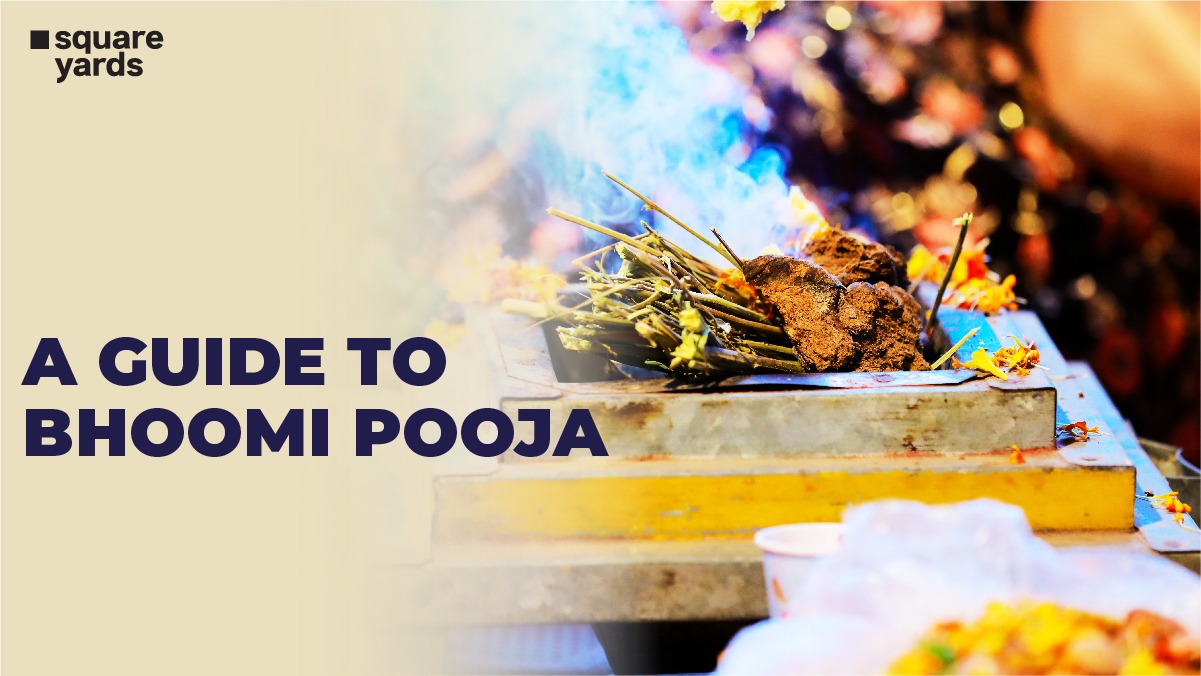Bhumi Pooja, also known as Sankusthapana in Telugu is the practice of offering prayers to the Almighty, Mother Earth, and other natural elements before beginning the construction of a home or land tilling activities for agricultural purposes. The foundation stone is also laid during the Bhumi Pujan. According to the Vastu shastra, before drilling, digging, or tilling the land, the approval of Mother Earth and the Gods is sought, and the endeavour begins with the symbolic placing of the foundation stone. It is also performed to ask forgiveness from the underground dwelling entities.
Table of contents
- In which Direction is Bhoomi Pooja Performed?
- Which Deity is Worshipped during Bhumi Pooja?
- Benefits of Bhoomi Pooja
- The Dos and Don’ts after You Acquire the Land
- Who Should Perform the Bhoomi Pooja?
- Things to Avoid during Bhoomi Pooja
- When to Perform Bhoomi Pooja?
- Impacts of Lunar Constellation on Bhoomi Pooja
- The Procedure for Bhoomi Pooja
- Items Required for Bhoomi Pooja
In which Direction is Bhoomi Pooja Performed?
The Pooja is done in the northeast corner of a construction site or in a field for favourable crop production as it is considered a sacred direction. It is performed for Vastu Purush, Goddess Bhoomi, Pancha boothas (the five elements of nature), and the deity of directions, and it purifies the land of all negative effects and Vastu doshas.
Which Deity is Worshipped during Bhumi Pooja?
The Vastu Purusha, Goddess Bhoomi, and Pancha Boothas are honoured in this Bhoomi Pooja rite (the five elements of nature). This pooja is performed according to the Vastu Shastra principles. In addition, the deity of directions is worshipped to rid the land of negative influences and Vaastu doshas.
Benefits of Bhoomi Pooja
The following is a list of the advantages of performing Bhoomi Pooja for house construction:
- Prior to the construction of a building or the usage of land for cultivation, it is essential to seek Mother Earth's blessings.
- This traditional pooja ensures that the earth is cleansed of all evils and that all negative energies are diminished.
- The Bhoomi Pooja facilitates the successful execution of tasks.
- It also ensures the health and happiness of those who are willing to live in the property that is to be built on that land.
- When land is used for agricultural purposes, it aids in the production of higher yields.
- The Vaastu Purusha is invoked during Bhoomi Pooja, and he bestows his blessings on the worshipper.
- This pooja cleanses the construction site, removing any negative energy.
The Dos and Don’ts after You Acquire the Land
Following are some things to take care of or perform after you acquire the land:
- Prior to constructing the house, it is important to create the compound wall.
- In comparison to the other walls of the home, the height of the southwest half of the wall should be taller.
- The walls on the east and north sides should be 21 inches shorter than the walls on the south and west sides.
- Following the selection of the construction site, the land must be planted.
- Keeping a calf or cow on the property, on the other hand, makes it even more auspicious.
- It is very beneficial to have an experienced priest do Bhoomi Pooja. It also brings happiness and wealth into a person's life.
Who Should Perform the Bhoomi Pooja?
The head of the family, along with his wife, should perform this pooja. This honouring rite for Mother Earth is advisable to be performed in the presence of a priest. The priest will be able to impart all of the details for a Shubh Muhurat of the pooja. He can also assist in the proper completion of the Bhoomi Pooja for house construction in a well-executed way.
Things to Avoid during Bhoomi Pooja
- Bhoomi Pooja should not be performed on Saturdays, Sundays, or Tuesdays. These aren't the best days for this puja.
- For such auspicious activity, Divaskarma, hadpaksha, and shraadh paksha should be avoided.
- Teethis in the fourth, ninth, and fourteenth molars are not suitable for this puja.
- The construction work should not be started if a female in the household is more than seven months pregnant.
When to Perform Bhoomi Pooja?
- Shravan, Margshirsh, Paush, and Kartik are the best months for Bhoomi pooja.
- The date for Bhoomi puja is determined by Vastu time. It frequently occurs twice a month.
- Monday and Thursday are the best days of the week for this pooja. For this pooja, these two days are particularly auspicious.
- Also, this pooja should not be performed on Saturdays, Sundays, or Tuesdays.
- For such auspicious activity, Divaskarma, Hadpaksha, and Shraadh paksha should be avoided.
Impacts of Lunar Constellation on Bhoomi Pooja
When choosing an auspicious day, one must first determine the lunar constellations' dates. If the lunar day falls between 1 and 7 or 19 and 28, it is considered unlucky to perform the pooja on those days. If it comes between the hours of 8 and 18, though, that day is highly lucky.
The Procedure for Bhoomi Pooja
Following are the steps which are performed for the procedure of Pooja:
-
Cleaning the Place
Cleaning the site is the first step in performing the pooja. In addition, the ground must be cleaned and all rubbish holes must be removed from the area.
-
Digging a Pit
The second step is to dig a pit in the construction site's northeast direction.
-
Direction
When doing the pooja, the owner should sit with his back to the East.
-
Idols
On a clean platform, place the idols of Ganesha, Goddess Lakshmi, and other deities that you worship.
-
Coconut
The coconut used in the pooja should be placed in the ground which is then covered with crimson fabric. Inside the dug-out pit, the silver idols of Naag and Naagin are also placed.
-
Lime
After the pooja, 5 limes are smashed and placed in the four corners and the centre of the location.
-
The Ganesh Pooja
This pooja marks the start of any auspicious work and is the principal ceremony. The pooja is then followed by a havan.
- Devi pooja, taking a Sankalpa, shatkarma, pran pratishtha, and Manglik dravya sthapana are some of the other main rites.
Items Required for Bhoomi Pooja
Following is the list of items required for Bhoomi Pooja:
- Kumkum (Red Sindoor)
- Turmeric Powder
- Camphor/Karpuram
- Sandalwood Powder
- Incense Sticks
- Fruits
- Flowers
- Set of Navratnas (9 Types of Gems)
- A packet of dry dates
- 5 lemon
- A set of Pancha Lohas (5 Metals)
- 2 Packets of Nava Dhanyam (9 Types of Seeds)
- Coins
- A White Cloth
- A Matchbox
- A lamp
- Cotton wicks
- 10 Panchpatras
- A Plate
- A Kalash
- A Bell
- A Bedsheet
- Plastic Plates
- God’s picture
- Foam Cups
NOTE: These may vary according to varied customs.
Frequently Asked Questions (FAQs)
What is Bhoomi Poojan?
The practice of offering prayers to the Almighty, Mother Earth, and other natural elements before beginning the construction of a home or land tilling activities for agricultural purposes is Bhoomi Poojan.
Why Bhumi Pujan is important?
Bhoomi Pujan is a Hindu ceremony dedicated to Goddess Bhoomi and Vastu Purush (deity of directions). Mother Earth is referred to as Bhoomi. The Purpose of this pooja is said to remove all negative impacts and Vastu doshas from the site, allowing for a smooth construction process.
Which day is good for Bhoomi pooja?
Monday and Thursday are the best days of the week for Bhoomi pooja. For this pooja, these two days are particularly auspicious.





